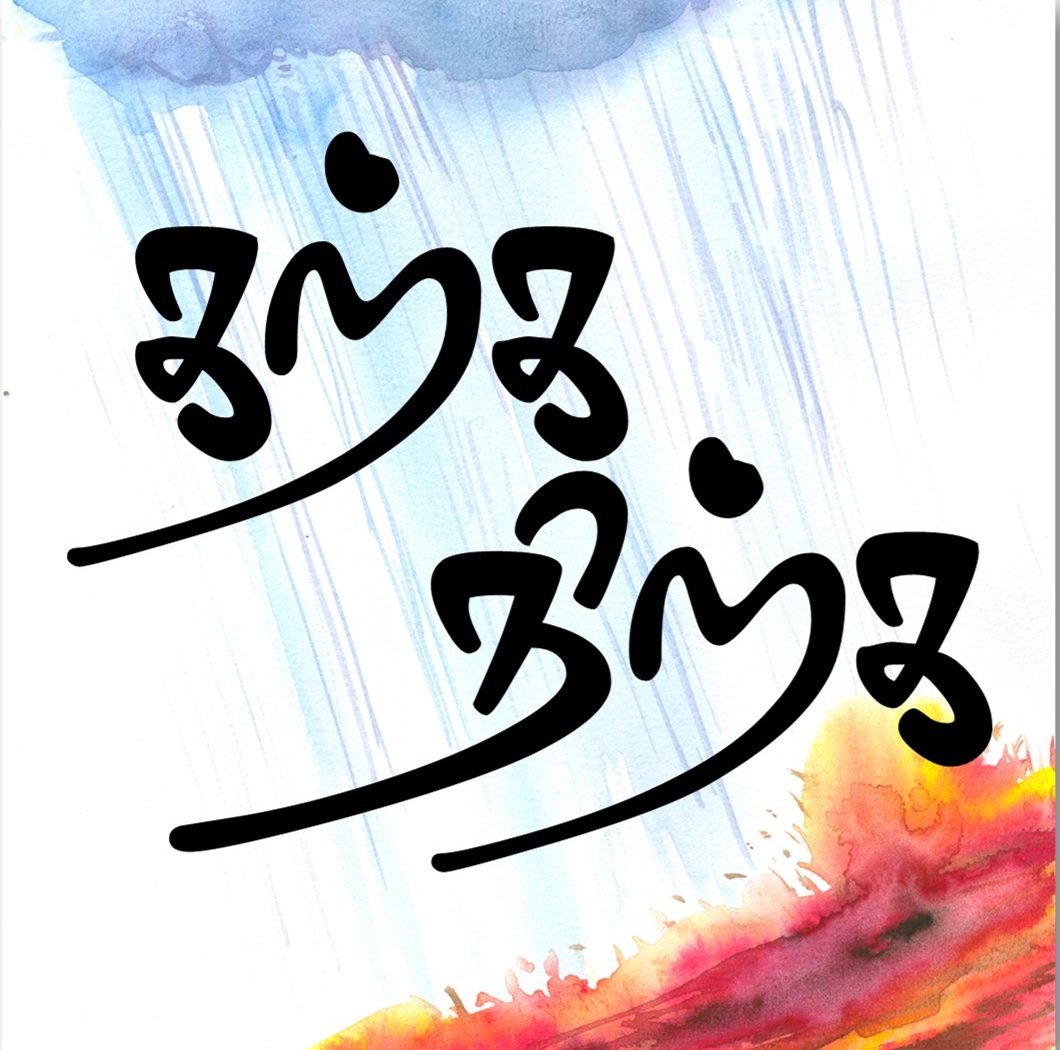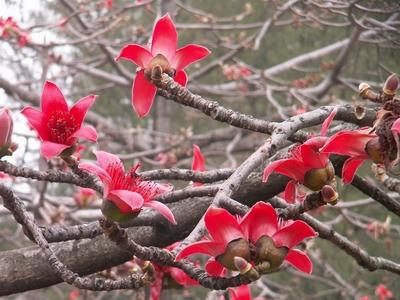I have tried to explain on poem of Auvaiyar in a visual manner. Lets first see this poem from Akanaanuru.
11. பாலை
வானம் ஊர்ந்த வயங்கு ஒளி மண்டிலம்
நெருப்பு எனச் சிவந்த உருப்பு அவிர் அம் காட்டு,
இலை இல மலர்ந்த முகை இல் இலவம்
கலி கொள் ஆயம் மலிபு தொகுபு எடுத்த
அம் சுடர் நெடுங் கொடி பொற்பத் தோன்றி,
கயம் துகள் ஆகிய பயம் தபு கானம்
எம்மொடு கழிந்தனர்ஆயின், கம்மென,
வம்பு விரித்தன்ன பொங்கு மணற் கான் யாற்றுப்
படு சினை தாழ்ந்த பயில் இணர் எக்கர்,
மெய் புகுவு அன்ன கை கவர் முயக்கம்
அவரும் பெறுகுவர்மன்னே! நயவர,
நீர் வார் நிகர் மலர் கடுப்ப, ஓ மறந்து
அறு குளம் நிறைக்குந போல, அல்கலும்
அழுதல் மேவல ஆகி,
பழி தீர் கண்ணும் படுகுவமன்னே!
தலைமகன் பொருள்வயிற் பிரிந்த இடத்து, ஆற்றாளாய தலைமகள் வேறுபாடு கண்டு ஆற்றாளாய தோழிக்கு, தலைமகள், ‘ஆற்றுவல்’என்பது படச் சொல்லியது. – ஔவையார்
Akanaanooru 11
The round blazing sun
creeps in the sky,
raging as a fire
in the forest,
and the silk cotton tress
is leafless
yet in flower
without a bud,
like a long array
of red lamps
in the month of karttikai
lit happily
by bustling women,
in the fruitless forest
where the pools are dry,dusty.
If only
he’d spent the time with me,
it would go fast,
if only he’d walk swiftly with me
on the dunes
over hung with flowering boughs,
all fragrant,
where the forest stream flows now
and the sand
is laid out like a woman’s bodice,
he could have what arms desire,
loving embraces,
body entering body,
and then my guiltless eyes
that now fill
ceaselessly like barren pools
fed by secret springs
could put aside
their daily sorrow
and find some sleep.
Poet: Auvaiyar
Translated by A.K.Ramanujan
This poem spell bound me for the simple reason ‘aEttu surakai vazhkaiku uthavathu’ . IF you have read the poem re read the poem so many times, never once you can understand the visual imagery portrayed in this poem.
This could be another ‘first in the net’ kind of effort, I am trying to visually present the imagery described by the poet.
Visual Imagery:
Ilavam or Silk cotton trees are very fast growing trees. In India their habitat seems to be forest with very very high temperature.
The poet now describes a stage where ‘the silk cotton tress is leafless yet in flower without a bud’.
First we’ll see how Ilavam flower look,

You can see it to be red flowers. If you see the green balls around they are the buds and also in deep back ground you can notice the tree has leaves.
So how does the ‘the silk cotton tress is leafless yet in flower without a bud’ look?
here it is
http://www.banana-tree.com/catalog%20images/image343.jpg
If you notice the photo , you will notice there are no leaves and nearly no buds and only the flowers are present. This is the state explained by the poet.
Lets look at flower more closely,

http://www.gardinonursery.com/images/Rareflora/bombaxmalab.jpg
You will notice that the flower has dark red petals and center with bright shades of yellow and red. With slight imagination it looks like a flame in red mud container , like below

Just think of so many Ilavam flowers scattered around in one tree and think about the whole stretch of trees in the forest with so many Ilavam flowers on them. The poet builds an imagery that the Forest with the silk cotton flowers looked like
‘like a long array of red lamps in the month of karttikai lit happily by bustling women’.
So the poet compare this ,

http://farm2.static.flickr.com/1194/1010558205_e05999a2bd.jpg?v=0
to this,

And this imagery can never be realised how beautiful it is, unless and until seen by our own eyes. There is no end to the imagination of the poets of the sangam. Their intimate knowledge of nature was beautifully blended into any love poems producing some brilliant imagery. I am happy to decode one of the imagery and see it with my own eyes.
Commentry on the poem:
The Thalaivan is away in search of pride or material(on war or business) ,he has to pass through palai region which i s fruitless ,dry and arid. But if Thalaivan was with Thalaivi they could have enjoyed their time near the river bed and enjoyed the pleasures of love(and love making). If that had happened she would have stopped crying and slept for while, which she is unable to do when her lover is away.
I have noted some thing really interesting in the translation and the original poem,
observe these lines by A.K.Ramanujan,
“loving embraces,
body entering body”
body entering body is clear indication that the activity was love making. So I had a doubt, from what ever I have heard Sangam poems never exclusively contains a word which means ‘making love’. So I went through the leixcon to find the meaning of the word …
The word means embrace as well as making love. So taking the words before it
‘மெய் புகுவு அன்ன கை கவர் முயக்கம்’
is laid out like a woman’s bodice”
the orginal tamil meaning also the same
” வம்பு விரித்தன்ன பொங்கு மணற் ”
only word to be researched here is ,
, n. cf. kañcuka. [M. kaccu, Kur. gajji.] A kind of corset worn by Indian women in ancient times; முலைக்கச்சு. கச்சது கடிந்து (கல்லா. 44).

——————————————————————————–
Reference:
Tamil Lexicon
Akanaanooru urai by U V Swaminathan Iyer
Poems of Love and War by A.K.Ramanujan
————————————————————————————————
Please post your comments.
Follow me in twitter http://twitter.com/vairam
Follow blog in Face book http://www.facebook.com/group.php?gid=83270822979&ref=mf
Orkut community http://www.orkut.com/Community.aspx?cmm=49797549



Oh! it’s really a beautiful visual explanation.. congrats.. and continue for ever..
Dhivakar
Vairam, fantastic visuals and great detail in explanation, thank you!!
Vairam, nice visual explanation,continue the good work.
Thanks,
Thanks, Vairam for beautifully capturing and explaning such wonderful verses. Wish I’d paid more attention to seyyul in school days 😦
You have even surpassed A.K.Ramanujam with great cross-referencing and creative ideas.
Your explanation with visuals has translated 100% what the poet meant 2000 years back.i also agree that you surpassed AKR..Please, link these articles to wikipedia..
பொருத்தமான காட்சி விளக்கம்.சங்கப்பாடல்களை இதுபோல் விளக்குவோம்.என் நவிரமலை கட்டுரை பாருங்கள்.பல படம் இணைத்துள்ளேன்.இப்பொழுது சென்றிருந்தால் இன்னும் சிறந்த படங்கள் எடுத்திருப்பேன்
மு.இளங்கோவன்
புதுச்சேரி
அருமையான விளக்கம்
Thankyou for explaining the poem . very interesting.
maanu.
please explain some more love songs by Avvaiyaar, Thankyou.
maanu
Will surely do some time soon… thank you for the comments.
hai
Awesome explaination!!!….Keep going 🙂
comparing a women’s bodice to sand dunes- has also been done by
Sri Krishnadevaraya – in his composition
Amuktyamalyada in telugu. while describing the beauty of andal. the poem is the story of andal and her marriage to sri ranganathar.
Link exchange is nothing else however it is just placing the other person’s blog link on your page at proper place and other person will also do same for you.
….arumai…..arputham……
Fantastic explanation. The visual is superb. You have strained much to this visual. Congratulations. Continue similar concepts.